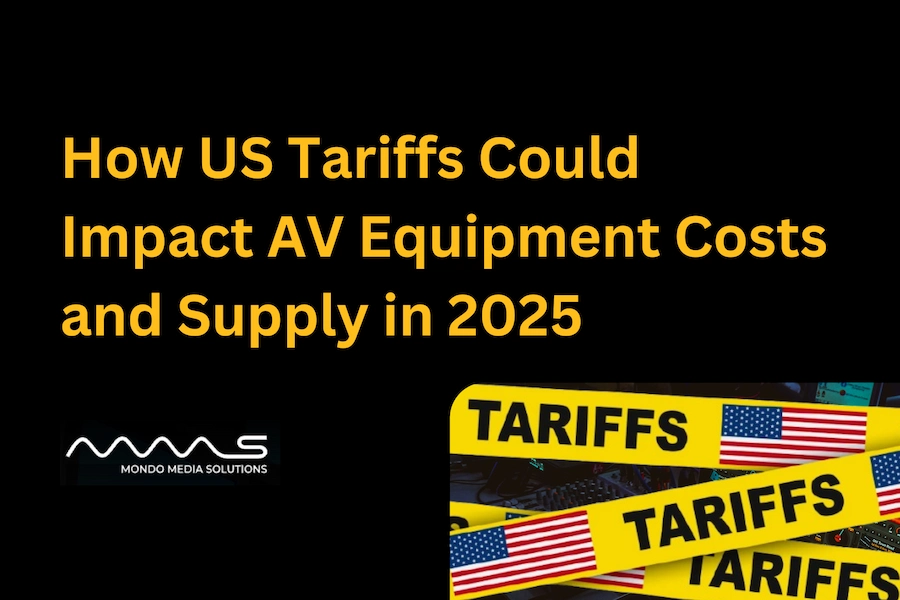In 2025, the U.S. has implemented significant tariffs on imported goods, aiming to address trade imbalances and bolster domestic manufacturing.
These tariffs, however, have far-reaching implications, particularly for industries reliant on global supply chains, such as the audiovisual (AV) sector.
This blog delves into the potential impacts of these tariffs on AV equipment costs and supply, offering insights for businesses and integrators to navigate the evolving landscape.
A Snapshot of the Tariff Changes
As of April 2025, the U.S. government’s recent tariff policies have introduced a 10% baseline duty on all imports, with higher rates for specific countries:
- China: 34%
- European Union: 20%
- Japan: 24%
- Taiwan: 32%
- Vietnam: 46%
These tariffs target various categories, including electronics, communication equipment, and subcomponents like semiconductors and displays.
Commercial AV Categories Most Likely to Be Affected
1. Video & Display Hardware
Large-format displays, video walls, and projectors, predominantly imported from Asia, are susceptible to cost increases due to tariffs. This could impact digital signage projects and control room installations, leading to higher expenses for businesses.
2. Cameras and Surveillance Systems
PTZ cameras and smart detection systems, which rely on components like sensors and chips, may face delays and price hikes as these parts are subject to new duties.
3. Audio Equipment
Microphones, speakers, and digital signal processors (DSPs), often assembled from globally sourced parts, are affected by tariffs on advanced chipsets, potentially increasing costs for AV-over-IP gear.
4. AV Control Systems and Touch Panels
Control systems incorporating microprocessors or displays sourced overseas may experience pricing shifts due to tariffs, affecting user interface elements like room schedulers and kiosks.
5. Infrastructure Components
Cables, mounts, racks, and connectors, while individually low-cost, can see significant markup swings in large-scale installations due to tariff-induced price changes.
Risks to the Commercial AV Industry
1. Project Cost Volatility
Tariffs introduce uncertainty in project budgeting, making it challenging for integrators to commit to fixed pricing, as costs may escalate between proposal and procurement stages.
2. Supply Chain Disruptions
Vendors may need to reconfigure supply chains in response to tariffs, leading to longer lead times, stockouts, or discontinuation of certain products.
3. Margin Compression for Integrators
Resellers and installers might be squeezed between rising wholesale prices and client resistance to increased costs, affecting profitability.
4. Vendor Instability
Smaller or single-source vendors may struggle to absorb increased costs or adapt sourcing strategies, potentially leading to instability in the supply chain.
Implications for End Customers
1. Higher Prices for New AV Installations
Sectors with high hardware demand, such as education, retail, and enterprise, may face increased costs for new AV installations due to tariff-induced price hikes.
2. Potential Delays in Project Timelines
Uncertainty around delivery schedules and product availability can lead to delays in project completion, affecting operational timelines.
3. Lower Flexibility in Customization
To manage procurement risks, integrators may favor standard packages over customized solutions, limiting options for clients.
4. Pressure to Extend Lifespan of Existing Equipment
Organizations might postpone upgrades, leading to potential performance and security trade-offs as existing equipment ages.
What Businesses Can Do to Prepare?
- Lock in Pricing Early: Secure pricing for upcoming AV projects to mitigate the risk of cost increases.
- Collaborate with Integrators: Work with AV integration partners to identify domestically sourced or tariff-exempt alternatives.
- Prioritize Modular Systems: Invest in modular, upgradeable AV systems to enhance flexibility and scalability.
- Consider Hybrid AV/IT Strategies: Explore hybrid solutions that integrate AV and IT for future scalability and resilience.
- Request Transparent Sourcing: Seek detailed sourcing breakdowns in project bids to understand potential tariff impacts.
Conclusion
The evolving tariff landscape presents challenges for the AV industry, affecting equipment costs and supply chains. By staying informed and proactive, businesses can navigate these changes effectively.
Engaging with experienced AV integration partners and adopting flexible strategies will be key to maintaining operational efficiency and cost-effectiveness in this dynamic environment.
